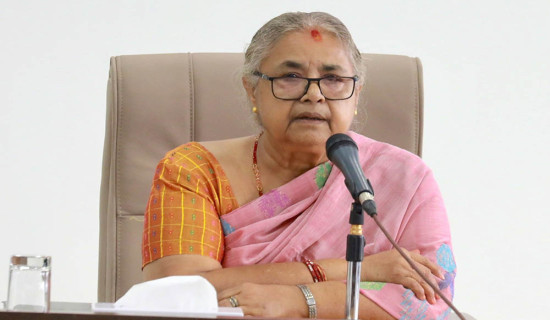- Wednesday, 29 October 2025
Climate change adds challenge for Nepal to become self-reliant in paddy
Kathmandu, July 7: With the onset of the monsoon season, agricultural activities have intensified across the country, focusing primarily on the cultivation of paddy.
Farmers have begun the annual cycle of planting paddy, the backbone of the country’s economy and a staple food for its population. About 22 per cent of the total paddy field of 1.4 million hectares land across the country has been cultivated by July 2, this year.
Paddy cultivation holds significant cultural and economic importance in Nepal, where agriculture employs a substantial portion of the population and contributes significantly to the nation’s Gross Domestic Product (GDP).
Nepal’s geographical diversity ensures a varied landscape suitable for different types of rice cultivation, from the terraced fields of the hilly regions to the expansive plains of the Tarai. Each region adds its unique flavour and texture to the rich tapestry of Nepali rice varieties.
The government has declared that it is an agricultural country and the decade of agricultural investment has been announced, but in practice, due to lack of availability of necessary service facilities and budget allocation and production increase, the agricultural sector has not developed as expected and continues to depend on import of cereals, including paddy and rice to meet the national demand.
The climate change emerging as a challenge to increase production of paddy over the years, said experts.
Paddy and economy
As the staple food crop, it is crucial for ensuring food security and plays a vital role in the country’s economic, social, cultural, and religious facets, said joint secretary and spokesperson of the Ministry of Agriculture and Livestock Development Dr. Hari Bahadur K.C.
Rice is not just a crop but a way of life for most Nepalis. It is consumed by over half of the global population and cultivated in approximately 114 countries, with Asian countries accounting for around 90 per cent of the total production and consumption.
While China is the largest producer of rice in the world, followed by India, Bangladesh, Indonesia, Vietnam, and Thailand, Nepal ranks 17th in terms of rice production.
However, in terms of rice consumption, Nepal ranks 13th globally. Rice is not only a key source of food but also a major source of employment in the agricultural sector.
Among the major food crops in the country, rice ranks first in terms of area, followed by maize.
These crops contribute significantly to food and nutrition security in Nepal. Agriculture contributes around 24 per cent to Nepal’s GDP, and above 62 per cent of households and 67 per cent of the population depend on it, he said.
Rice alone contributes about 15 per cent to the agricultural GDP and 5 per cent to the overall GDP.
It accounts for 67 per cent of food supply, 23 per cent of protein intake with 138 kg annual per capita consumption, said K.C.
No end to rice import
Despite the country’s abundant potential for grain cultivation, it is not self-sufficient in food, leading to significant expenditures on cereal imports, including paddy, to meet national demand each year, said K.C.
According to recent reports from the Ministry of Agriculture and Livestock Development, Nepal’s annual rice production has shown incremental growth over the past few years, yet it falls short of the nation’s consumption needs.
In 2023, Nepal produced approximately 5.7 million tonnes of paddy, marking a slight increase from the previous year. About 5.48 million tonnes of paddy was produced in fiscal year 2022/23. Similarly, Nepal had grown 5.62 million tonnes of rice in the fiscal year 2020/21.
The paddy is being cultivated in about 1.4 million hectares of land. In recent years, due to the growing population, the gap between consumption and production has led to an annual import of around 750,000 tonnes of paddy/rice, said Dr. K.C.
This import constitutes only about 15 per cent of the total consumption.
The changing rice-eating habits of consumers, favouring fine rice varieties over coarse ones, have contributed to import dependency, he said.
In the last four decades, per capita rice consumption of Nepalis has almost doubled from 74 kg to 138 kg per year.
“Due to the increase in transportation facilities, there has been an increase in the availability of rice even in the mountains and high mountains. It is evident that there has been a change in people’s eating habits,” he said.
“The rice cultivation and production heavily depend on rainfall due to the lack of irrigation facilities on most of the farms. Unusual rainfall patterns can lead to fluctuations in productivity,” said Dr. Ram Krishna Shrestha, joint secretary and chief of Agriculture Development Division of the MoALD.
According to statistics from the Department of Customs, paddy and rice imports amounted to Rs. 21.13 billion in the first 11 months of the fiscal year 2023/24. Notably, rice imports have decreased compared to previous years, with Rs. 33.65 billion imported in 2019/20, Rs. 50.78 billion in 2020/21, and Rs. 47.57 billion in 2021/22.
“There is also a question as to why Nepal, a country that was a rice exporter until the 80s, has become an importer. The answer to this question is linked to social conditions, technological and infrastructural reasons and our eating habits,” said K.C.
In response to the persistent dependency on imports, agricultural experts emphasise the importance of a comprehensive strategy that integrates technological innovation with policy reforms to bolster domestic rice production.
Efforts to diversify crops, enhance storage facilities, and mitigate climate-related risks are also critical in achieving long-term food security goals for Nepal, said Shrestha.
Challenges
Like many agricultural sectors globally, Nepal faces challenges in paddy production. These include dependence on monsoon rains for irrigation in many areas, limited mechanisation in farming, and issues related to land fragmentation, said Dr. Shrestha.
The climate change has been adding additional problem in increasing agricultural produce, including paddy, over the years as Nepal’s agriculture depends on rain, he said.
The government has been encouraging research and development of climate-adapted techniques and available technologies to mitigate the negative impact of climate change on rice cultivation, he said.
The government has celebrated the National Paddy Day on Asar 15 with the slogan of “Climate resilient farming, increase in paddy production”.
“Mainly paddy is the crop which needs huge amount of water. Owing to the growing climate change, the sources of water have dried and also drought increased. That is affected in the growth of paddy production and hit to make achieve the target to make the country self-reliant in paddy,” said Dr. Shrestha.
“Some years, the rains come late, leaving the fields parched and the seedlings struggling to survive. Other times, the rains arrive with such intensity that they wash away newly planted crops, leaving farmers devastated,” Shrestha said.
In the meantime, the rising temperature caused by the climate change has increased drought which is also problematic not only for paddy plantation but also affecting the yield.
There is no alternative to adopting the climate-friendly technology as well as seeds for increasing paddy production against climate change, he said.
The off-seasonal rains have been witnessed which affects paddy harvesting as well. Two years ago, the off-season rains that occurred in October 2021 damaged paddy ready for harvest to the tune of Rs. 9 billion.
Due to the absence of a land use policy, fertile land is being destroyed through the construction of concrete structures under the guise of development projects, he said.
Furthermore, lack of appropriate technologies tailored to specific geographical areas poses a challenge to farmers, particularly in cultivating crops like paddy. While modern technologies such as paddy transplanters are being utilised in some parts of the plains like Chitwan, these advancements are yet to reach small-scale farmers.
Way forward
In the current situation, the way forward is not as easy to make the country self-reliant in paddy shortly as the government thinks.
“It is not impossible when the attention and priority of the state is food security and agricultural development by expanding the area of Chaite paddy plantation and productivity ensuring the subsidy on agricultural inputs, including mechanisation. For this, it seems that the productivity of main season rice should be improved and the cultivation of Chaite paddy cultivation should be expanded,” said K.C.
As main season paddy production cannot meet the total demand of the country, there is no option but to expand the area of Chaite paddy based on national priority as an alternative, he said.
At present, Chaite rice is being cultivated only in about 140,000 heactares, it will be increased by another 100,000 hectares and productivity increased by 1 tonne/ha to 5 tonnes per hectare in case of main season rice, he said.
“If productivity can be increased, it seems that we will be self-sufficient easily,” he said.
By promoting climate-resilient and farmer-friendly technologies, the government hopes to improve rice production in the face of climate change challenges, said Shrestha.
Strategic efforts are being made at all three levels of the government to reduce the significant gap between potential productivity and actual productivity in rice, he said.
As climate change is having its impacts on agriculture, adopting climate-friendly practices and seed varieties is the call of the hour.



-original-thumb.jpg)












